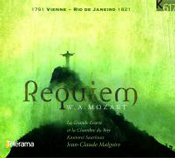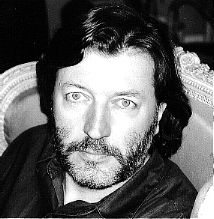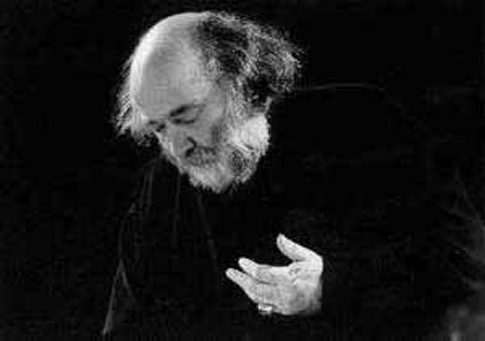
13 Jan 2008
MOZART: Requiem (Neukomm ed.)
As is often the case, last works that remain incomplete at the time of a composer’s death, are quick to invoke controversy and conspiracy theories.
The Gran Teatre del Liceu in Barcelona, after suffering a calamitous fire in the early 1990s, reopened in 1999, lovingly restored. TDK has released a series of DVDs from the Liceu since that date, providing ample evidence of the world...
Premiered posthumously, the symphonic song-cycle Das Lied von der Erde by Gustav Mahler (1860-1911) remains one of his defining works because of its synthesis of song and symphony, two genres he pursued throughout his career.
In 1851 during his first season as music director in Düsseldorf, Robert Schumann presented a performance of Bach’s St. John Passion, and unsurprisingly adapted the score both to nineteenth-century taste and nineteenth-century practicalities.
The centrality of dance at the French court helped bring grace, order, and political allegory into the characteristic prominence they enjoyed during the reigns of Louis XIV and Louis XV; theatre presentations of all stripes were infused with choreographic diversions.
In tandem with the recently released set of Sir Simon Rattle’s recordings of Mahler’s symphonies on EMI Classics, the set of the complete symphonies by Jean Sibelius merits attention.
As much as Richard Wagner espoused opera reform in his theoretical writings by bringing to his works for the stage a closer unity between music and text, his actual means of doing so at times involved the use of orchestral forces that sometimes overwhelmed the sung word.
The budget label Gala purveys live performances both historic and relatively recent; of the three discussed here, the La Scala Fedora dates back to 1931, while the Attila comes from a 1987 La Fenice performance.
National styles of music in the seventeenth century were often distinctive, and in the case of French and Italian music, famously so.
With its recent release of Mahler’s symphonies conducted by Sir Simon Rattle, EMI Classics makes available in a single place an outstanding contribution to the composer’s discography.
This DVD records and commemorates a 1981 production of Parsifal in its Bayreuth lair, and the singers of 1981 are as fine as recollection might paint them.
Once the custom of the world's opera houses was to translate great operas into the language of each respective country.
Repackaging older recordings having become the primary focus of a classical recording company's business, Deutsche Grammophon budgeted some funds for art direction for its budget series called "Opera House" (although that appellation only appears in a link found on the back inside cover of the sets' booklets).
Of Rosenkavaliers on DVD, the classics tend to be lovingly detailed productions, going back to the film of Herbert von Karajan leading an exemplary cast, with Elizabeth Schwarzkopf's iconic Marschallin.
Despite an unsurprising degree of conservatism in liturgical music, devotional life in Rome often found ways of taking advantage of modern musical style.
“Her fioritura is priceless, breathtaking, and effortless.”
The English composer Nicholas Maw has been a major voice since the 1960's, with a wide range of works that include the 2002 opera, "Sophie’s Choice," a violin concerto for Joshua Bell (1993), and the monumentally-scaled orchestral work, "Odyssey" (1972-87).
This is a valuable new recording of a work that is only rarely heard, but was widely influential and wildly popular during the eighteenth century. Philosophe Jean-Jacques Rousseau wrote both the libretto and the music, with mixed success.
This disc is well worth the price for the first track alone: the opening measures of Jean-Féry Rebel’s “Cahos,” (Chaos), written in 1737 or 1738, may cause you to wonder if you accidentally left a Stockhausen or Ligeti disc in the changer.
This recording made half a century ago will not be anyone’s first choice unless one is a die-hard fan of one of the principal singers; neither of them belonging to the absolute top in their profession.
Why should anyone buy a German language broadcast of a delicious French opéra-comique?

As is often the case, last works that remain incomplete at the time of a composer’s death, are quick to invoke controversy and conspiracy theories.
Where unfinished works are concerned, the question of authenticity becomes a prominent issue for musicologists and, for that matter, anyone who finds intrigue in a little bit of mystery. What would the end be like? Was this really how Mozart intended it to be? Several years ago, the feature film Amadeus, portrayed that Antonio Salieri was responsible for completing the Requiem, however, three composers are actually responsible for its completion, not including him. Salieri was not the composer to whom Mozart dictated the Requiem on his deathbed. Franz Xavier Süssmayer was responsible for writing the Sanctus, Benedictus, and Agnus Dei. For the ending he merely reprised the music of the opening Kyrie. Earlier, Josef Leopold Eybler had been commissioned to complete the Mass by Mozart’s widow. Finding the task too difficult, he was unable to complete it and passed the responsibility to Süssmayer. The unfinished manuscript remains a remarkable piece of evidence that contributes to the enigma of Mozart’s Requiem.
 Sigismund Neukomm
Sigismund Neukomm
Now, a fourth composer has been associated with the mysterious Requiem: Sigismund Neukomm (1778-1858) provides an alternative conclusion. Once a pupil of Michael Haydn in Salzburg, the Austrian Neukomm was both a valued collaborator of Joseph Haydn and an untiring traveller. In 1816, he journeyed to Rio de Janeiro where he met Father José Mauricio Nunes Garcia (1767-1830) (mestre de capela to Emperor João VI), who asked Neukomm to write a Libera me which would conclude the first performance of Mozart’s Requiem in the New World (conducted by Nunes Garcia on 19 December 1819 at the Church of the Brotherhood of St Cecilia in Rio de Janeiro). Neukomm put his final touches to the score on 24 January 1821, according to the recovered manuscript. This, live, Télérama recording is the first to use the Neukomm ending.
The Requiem Aeternam begins with an appropriate funeralistic tempo that is well chosen by conductor, Jean-Claude Malgoire as he leads the woodwinds and brass into a crescendo, culminating in the entrance of the chorus. Since this is a live recording, the balance between the orchestra and chorus, at first, is unbalanced, such that the choir is slightly overpowered by the orchestra. For a listener who is unfamiliar with the Requiem, the suppression of the voices makes the text rather unintelligible. The unity of the choir’s inflections, however, allows for some control over the imbalance. The choral voices, in and of themselves blend remarkably. Soprano, Hjordis Thébault’s entrance on Te decet hymnus, Deus is elegant, but perhaps lacks that silvery, pure quality that is often required of a Mozartian soprano. The dotted-16th entrances, by the low strings, enter with an effective dramatic purpose at the Exaudi orationem meam cleverly colouring the text. As with all good choral writing, Mozart reserves the use of polyphony (more than one interacting voice in simultaneous motion) for the repetition of the Requiem Aeternam phrase, where it had previously been set homophonically (in unified by harmony central rhythmic blocks). Since the text has already been stated, it is now enhanced by the multiple entries of diverse voices.
At the Kyrie Eleison, a grand fugue, complete with vibrant melisamas and sequences in an ascending manner, is precisely intoned by the orchestra and chorus. Perhaps the tenors here sound a little strained because of the high tessitura and expansive range that Mozart demands. The web of polyphony ends on a wonderful diminished chord enhanced by the brass superimposed over what had been a more dominant string section. Choirmaster, Kantorei Saarlouis, exhibits excellent control over the choral properties here, Malgoire equally defines control and artistic aptitude with his orchestra.
The second part, otherwise known as the Sequence, begins with the most ominous Dies Irae. Malgoire, inflects the morbidity of the text by demanding a more pronounced use of the brass. Unfortunately and as a result, the voices seem rather unbalanced where they might have been more prominent here. Comparatively, in the Quando judex est venturus, the orchestral texture thins out and allows the chorus to emerge beautifully and display their affective and precise articulation.
 Alain Buet
Alain Buet
In the Tuba Mirum Mozart introduces the third of three textures used in the Requiem. In the first two sections, he uses homophony and polyphony (contrapuntal). In the Tuba Mirum he introduces his cantabile. The opening chord is delineated by a solo horn and juxtaposed with a noteworthy entry by Bass, Alain Buet, whose lyrical bass voice is enhanced by effective diction, expressivity, and articulation. The following entrance by Tenor, Simon Edwards on Mors stupebit et natura is equally as impressive, especially in conjunction with the simultaneous entrance of the strings after the solo horn introduction.
Simon Edwards continues into the Liber Scriptus where a horn interjects with subtle interludes. Mezzo-soprano, Gemma Coma-Alabert, in a rather weak entrance, commences with In quo totum contenitur. Her voice is lovely but lacks sufficient tone in the lower and middle registers where the orchestra overpowers her well-enunciated diction.
As the sequence continues, Hjordis Thébault continues with the Quid sum miser. Permeated by a series of statements and pauses between the text, the Cum vix Justus sit securus, indicates a questioning motive. Unfortunately, Ms. Thébault’s inflections do not ultimately achieve this stylistic gesture, however the solo quartet, upon their entry, elegantly evokes the questioning manner required for this text. The harmonic writing for the solo quartet is a definitive example of Mozart’s elegance and ability to create unified blocks of sound from four individual voices, as he often achieved in his string quartets. The four soloists achieve this affect gracefully. Malgoire’s orchestra ends with a beautiful cadence that moves from peace into chaos.
In the Rex Tremendae, another of the significant texts in the Requiem, the interplay between the dotted sixteenths in the strings and the blasts from the horns, is wonderfully captured by Malgoire. In this most stirring and often memorable movement of the sequence, the choir enters with a wonderfully rolled Rex, which is not often applied by choruses. The affect of the rolled consonant is, in fact, appropriate here. Rather than concentrating the melody into the voices, Mozart offers it to the orchestra with interplay by the choir. Malgoire is masterful in this section and becomes seemingly attentive to the balance and dramatic interchange between instruments and voices. The chorus functions almost as an obbligato. In this instance the orchestra is rightfully louder than the chorus, that enunciates with superb diction. The ensuing Salva Me is expressively presented by the sensitive interchange between the choristers.
Woodwinds open the Recordare with a reminiscent tone, followed by the strings and the entry of the mezzo, and bass, and followed by soprano and tenor. The polyphonic setting of the movement, with the strings doubling the vocal parts, is moving and well orchestrated by Malgoire. A few of the entrances by the solo quartet are not always in complete unison, rhythmically. The entries of bass, Alain Buet, however, are noteworthy for his expressive dramaticism.
The Ingemisco moves in well-chosen triple time and the homophonic textual setting is appropriate and well effected by the quartet. Mezzo, Coma-Alabert produces a lovely artistic moment here, where her voice becomes the central point around which the others circulate. In this movement, the orchestra does not overpower the voices, where in other movements it was a little too overbearing. Malgoire is attentive to the articulation and expressive nuance of the singers.
 Jean-Claude Malgoire
Jean-Claude Malgoire
One of the significant attributes of the Confutatis is the extreme enharmonic and chromatic modulations. Successive lines of text are given in A-minor, Ab-minor, G-minor, and then via F#-major and F-major. Where the text, Confutatis Maledictis predominates, Malgoire allows the percussion section and brass to lead the orchestra. It becomes a character in its own right. Contrasted by the etheareal Voca me cum benedictis the chorus invokes the representation of light and dark, where death is the dark hue. An almost airy sound is generated on the Voca me entrances, that are appropriate and wonderfully colouristic. The strings continue with in ostinato where numerous luscious dissonances are signified by Malgoires’ artistic attention. The juxtaposition of the Dies irae text and the Oro supplex et acclinis is one of Mozart’s magnificent moments in the Requiem and is well applied by the chorus and orchestra as a whole.
The more lyrical Lacrymosa moves into unexpected keys and is where the chorus displays its ability to use dynamic expansion to its fullest. The interplaying horns and later percussion elegantly merge into the mix. In essence, Malgoire re-defines the balance issue that was evident at the beginning of the recording; through each movement, the balance becomes a tool of his own artistry. The orchestra and percussive elements of the Lacrymosa are balanced beautifully. In addition, the strings of Malgoire’s orchestra are perhaps the most remarkable element, unified with precise articulation, especially for Mozartian aesthetic stylings.
The sequence ends and moves into the Offertoire with the Domine Jesu. Again the chorus is much more prominent here, and is mindful to create lovely entrances of Libera eas that occur in a stretto-like fashion. They are wonderfully complimented by the orchestra, which becomes the underlying emotional figure with its continuing ostinato rhythmic pattern. The soloists enter in fuga at Sed signifier sanctus Michael with perhaps their most stunning moment of the recording. The solo quartet functions as a unit against the chorus, rather than four individual soloists. One might equate it to the function of the small ensemble in the Baroque concerto grosso. The triple meter change at Hostias et preces tibi is surely to evoke the trinity. Mozart sets this homophonically, with the strings playing in syncopated rhythms. The chorus continues to be well balanced with the orchestra, even now as the lower strings move in step downward descent. Again, as is typical of good choral writing, the chorus repeats the text in polyphony where, initially, it was stated homophonically, enhanced now by the horns and interjecting trumpets.
The following section requires that the orchestra and chorus function as a unit with the opening, thrice invoked Sanctus. Beginning in fuga, the Hosanna allows an opportunity for the orchestra and chorus combine forces and increase tension through dramatic inflection. Although Mozart could have likely expanded the Hosanna, he keeps it to a minimum and intends it to build toward, what is often, the most beloved moment of any mass, the Benedictus. Mezzo, and soprano enter first, but Coma-Alabert’s mezzo again lacks in the lower register. The expressive quality of this section seems slightly rushed where it could have been more liberal; yet, the beauty of the quartet is still evident. The binary form of this section is separated by a lovely moment in the clarinets that divides the opening text such that it now begins with bass Alain Buet, who expresses most beautifully in this section. His artistry is unparalleled on this recording and he shows himself to be an artist of consummate ability and expression. His bass is never forced and is liquid in its seemlessness. Unfortunately, to make the solo quartet stronger, the two outer voices should have functioned similarly, but Ms. Thébault’s soprano failed to produce a parallel seamlessness.
The Agnus Dei, well inflected by the orchestra is enhanced with percussive strokes and accents to support the thick, overall orchestral texture. Once again, the chorus dominates the movement with interjecting entrances by the woodwinds and strings, which beautifully produce circular scalar-like patterns in the violins.
The entrance of mezzo, Coma-Alabert in the Lux Aeterna is lovely, and is perhaps her most eloquent moment in this recording. The lyrical quality of her singing is appropriate and compliments the woodwinds that interact with her voice. The Cum sanctis tuis begins another moment of polyphonic majesty, with percussion and orchestra of the same order. The choral sopranos were, unfortunately, a little weak in this melismatic section. Some voices protruded in a moment that should evoke blocks of sound traveling together, rather than detached. This is the longest moment of fuga, which dually acts as a crescendo leading toward the following section. Its culmination is a beautifully projected diminished chord before the onset of the Libera Me, one of the crowning moments of this performance.
The Libera Me, which is the focus of this recording: the alternate conclusion to Mozart’s Requiem, is, in fact, more discreet than the one typically used. Neukomm conformed precisely to Mozart’s scoring, however there are more parts added here. The orchestra is slightly thicker than that used in the remaining portions. The Tremens factus sum ego is surprisingly beautiful and affective, with hushed vocal tones and detached entrances separated by silence. The first appendix offers new instrumentation and the addition of horns, flutes, and oboes. Unfortunately, this movement does have a more pronounced orchestral flavour, and is not as attentive to the orchestral function Mozart applied to preceding movements; yet, it offers an alternate possibility to a work without ending. Should works without endings simply remain unfinished, rather than end with the flavour of another composer? To confront the problem of disconnectivity, Neukomm cleverly repeats the opening music of the Requiem, which is appropriate and respectful to Mozart.
This recording is quite excellent if not for a few unbalanced moments. It is an interesting historical edition in regards to the Neukomm Libera Me, and also an opportunity to hear bass, Alain Buet, who is more than spectacular in this recording.
Mary-Lou P. Vetere, 2008
PhD (ABD), M.A., Mus.B